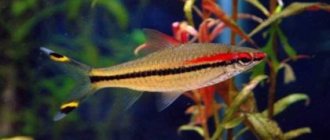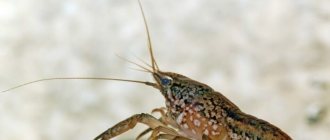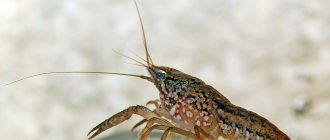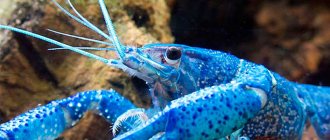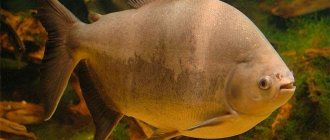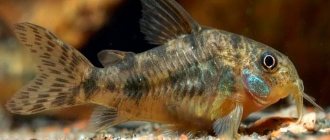The red-tailed barb (lat. Barbonymus schwanenfeldii, formerly Puntius schwanenfeldii) is a very large fish from the genus Cyprinidae. It can reach a body length of 35 cm. Its natural color is silver with a golden tint. There are also several color options, which are also very popular - gold, albino. The golden bream barb is an artificially bred variation; this color does not occur in nature.
Habitat in nature
The bream barb (Barbonymus schwanenfeldii) was first described by Peter Blacker in 1853. It lives in Thailand, Sumatra, Borneo and Singapore.
The red-tail inhabits very large water streams, such as rivers, canals, and lakes. During the rainy season, it moves to flooded fields to feed and spawn.
In nature, it eats algae, plants, insects, small fish, even carrion.
Attention!
Sometimes, in order to sell this simple and inconspicuous fish, cunning sellers resort to cunning. Therefore, you can often find bream-like barbs of purple, green, pink and other unnatural colors in pet stores or at the Bird Market. Remember that all this is an artificial dye that was injected subcutaneously into the body of the fish. Such animals are more prone to diseases, not to mention the fact that their life expectancy decreases significantly. When purchasing such fish, you do so at your own risk.
Difficulty in content
A very unpretentious fish that is very easy to keep. They are not picky eaters and do not require special conditions, but they grow very quickly. The small, silvery fish you bought may grow larger than your aquarium!
Since the bream barb needs to be kept in very large volumes, this is not suitable for every aquarist, especially a beginner.
Keeping fish is not difficult, but they grow very quickly. Often they sell it as a juvenile and don’t say anything about its size, but it quickly outgrows the average hobbyist’s aquarium and needs very large volumes.
Although the redtail is generally quite peaceful towards large fish, it eats small ones with pleasure, so it is completely unsuitable for general aquariums.
The aquarium for him should be large and spacious, with fine gravel at the bottom and dense thickets in the corners. However, it loves to dig the soil and simply destroys plants, so you need to keep hardy and large species.
Species of the Lamellar Barb
There are 2 common types of Leopard Barbs, which are kept by aquarium enthusiasts.
The fish are distinguished by a torpedo-shaped body and a high dorsal fin. The small head and classic forked tail, coupled with the wide body, evoke associations with a diamond shape. Depending on the variety, they reach a length of 20 to 40 cm. The lifespan of the Flaky Barbus ranges from 8 to 10 years, but there are cases where the fish lived longer.
Each species is endowed with striking external characteristics, despite this they are often confused:
- Foil (schwanenfeldii, "tin foil") - grows quickly and reaches 35 cm in length. The body color is silvery and dark. The tail is red, framed with black stripes above and below. The dorsal fin is of the same shade along the edge and red at the base. The ventral ones are pinkish in color without inclusions of other colors.
- Redtail (altus, “red-tailed tin spine”) - does not grow more than 20 cm. This species is popular with aquarium enthusiasts. The body is gray with a golden tint, light. The fins are pinkish-red, without stripes or inclusions. The dorsal ridge is transparent and high.
Currently, there are multiple different hybrid forms obtained as a result of selection, including golden and “reddened” strains. They are bred for commercial purposes, since the natural color of the Leopard Barbus is faded, bright varieties are in better demand.
Feeding
Omnivores, eat all types of live, frozen and artificial food. They also like large foods such as shrimp or earthworms. But, despite the fact that they love animal food, they also need a lot of plant food.
Be sure to feed with seaweed, flakes with spirulina, cucumbers, zucchini, lettuce, spinach or other foods high in fiber.
It is advisable to feed them twice a day, as much as they can eat in 3 minutes.
Substrate, decor
In order for the maintenance of the barb to be successful, the bottom of the container is filled with coarse sand or crushed gravel. Along the perimeter there are snags, stones, tunnels and other artificial shelters. Since the fish actively move around the container, all decorative elements are carefully attached.
Before introducing decorative elements, treatment is carried out. For these purposes, running water and special solutions are used. After all, store-bought products can be infected. If they are placed without pre-treatment, then infection will enter the aquarium.
Keeping in an aquarium
The bream barb grows very quickly, is of impressive size and actively swims throughout the aquarium.
In addition, it must be kept in a flock of at least 5 individuals, so calculate how much size it needs. Such a flock requires approximately 800 liters.
Since they eat a lot and greedily, a large amount of food remains, which quickly spoils the water in the aquarium. A powerful external filter is required that will purify the water, create a current and supply the water with oxygen.
The aquarium also needs to be covered, since barbs are very skilled jumpers and will show their skills if possible.
Since they live mainly in rivers with strong currents, it is better to create conditions in the aquarium similar to natural ones.
There is a current, there is fine gravel at the bottom, large stones, since they simply turn over the small ones.
We need plants, but choosing them is quite difficult, since the breams eat all the soft species and try to eat the hard ones. Large Echinodorus and Anubias work well.
In general, keeping bream-like barbs is not difficult; the main difficulty is the volume they need. Water parameters may be different, but the ideal ones will be: temperature 22-25 ° C, pH: 6.5-7.5, 2 - 10 dGH.
Diseases
Barbus Schwanefeldii has good immunity and is practically not susceptible to major diseases. Diseases are most often associated with improper living conditions.
Like other members of the family, they are prone to overeating. In this case, they may freeze in place upside down. This behavior in some cases signals that the fish is infected with helminths.
The only disease characteristic of all cyprinids is rubella. It can be caused by viruses and certain types of bacteria. The disease manifests itself in the form of hemorrhages throughout the body, especially in the belly and head, as well as at the base of the fins, loss of coordination, bulging eyes, ruffled scales, and dropsy. Rubella is treated with the use of immunomodulators (roncoleukin, leukocyte interferon), sera Baktopur direct, chloramphenicol helps well.
The bream-like barb is unpretentious in keeping, has an interesting appearance, and its behavior is interesting to observe.
The main aspects preventing its widespread use are its size and the need for a very large capacity container. Not everyone can afford such an aquarium.
Compatibility
A non-aggressive species, but all small fish are considered exclusively as food. You should not keep them with slow-swimming fish, as the activity of bream-like barbs will be stressful for them.
The best neighbors are large and non-aggressive species - shark baloo, striped platidoras, plecostomus, kissing gourami.
In nature, they swim in large schools. So in an aquarium they need to be kept in a flock of at least 5 pieces, otherwise they will either be aggressive or, on the contrary, too timid.
Aquarium water parameters
In order for the bream barb to develop normally, the tanks are equipped with filtration equipment. With its help, the required flow is created. Compressors and aeration units are used to purify water and saturate it with oxygen.
Water is prepared to fill the container. It should have the following parameters:
- Temperature range: from 22 to 25 degrees.
- The degree of hardness is 18 units.
- Acidity level – 7 units.
- Water changes are performed every 8–10 days (30 percent).
The chemical composition of the aquarium fluid does not have a significant effect on the state of the phenotypes. But filtration equipment is used for control.
General information
Barbs are ray-finned fish from the Cyprinidae family. Due to their unpretentiousness, medium size and interesting colors, they are widely distributed in the aquarium hobby. This collective group includes several genera. Mostly gregarious species that easily adapt to a variety of living conditions. In addition to natural colors, there are breeding forms and fluorescent fish (GloFish).
Barbus glofish
They have a reputation for being aquarium bullies; some aquarists even consider them predatory fish. But in reality, interspecific aggression in most cases is associated with errors in keeping fish (too few individuals in a group, incorrectly selected neighbors).
Features of behavior
By its nature, the bream barb, in addition to being very active and nimble, is also timid, so be prepared that any sudden movement or loud sound, for example, knocking on the aquarium, will be a source of stress for it.
He will most likely prefer to flee from an unknown danger. To prevent his timidity and timidity from turning into a disaster, the aquarium should be covered with a lid, and decorating its area with objects with sharp edges should be completely abandoned.
By the way, the second significant drawback of this type of fish is associated with plants. The thing is that, like some species of cichlids, barbs really love to feast on lovingly planted plants of the underwater garden. There is no flora that the barb would not taste.
They also love to dig in the ground in search of something tasty, so in the process of hunting they can accidentally damage the root system of plants. To prevent this from happening, underwater flora must be selected with well-developed, strong roots, and the plants themselves are best further strengthened in the ground with stones.
It is advisable to use fine gravel or sand as bottom litter so that the fish does not injure itself by rummaging through it with its muzzle.
To emphasize the color of the bream barb, you can add dark soil and place the aquarium itself on a dark background. This will make the silver scales of the fish look most advantageous.
Breeding
At home, breeding another generation of barbs will be very difficult, almost impossible. During one spawning, a female can lay from 200 to 1000 eggs. Now imagine how big the aquarium must be to accommodate all these rather large fish. But in principle, extreme sports fans will enjoy this activity. You can try, but all animals intended for sale are bred on special fish farms.
Life expectancy is 8-10 years.
The barb more than compensates for all its shortcomings with liveliness of character and interesting behavior. And its unpretentiousness and omnivorous nature make it an excellent pet even for a beginner in aquarium keeping.
Bright colors and fancy shapes are not necessary, because elegance can be hidden in simplicity. But not everyone can see it.
Reproduction
Breeding the mossy barb and the Sumatran barb is identical. The fish reach sexual maturity by four months, when the body length is 3-3.5 cm. For spawning, a pair is selected in advance that stands out most in the school in terms of behavior and external characteristics. A few weeks before fertilization, the chosen ones begin to be fed with live food.
The mossy barb is a spawning fish that does not worry about its offspring and eats it with great pleasure.
For reproduction, a spawning tank with a mesh bottom is prepared, where the fish will spawn. The water should be soft and highly acidified. Inside there is more vegetation with medium-sized foliage. The selected couple is transplanted into it. Spawning usually starts early in the morning.
If the parents do not show any particular desire to spawn for one or two days, they speed up the process artificially - they replace part of the water with warm water. The female is capable of laying up to 200 yellow glassy eggs at a time. The male immediately begins to fertilize them. After this, the parents are returned to the common aquarium.
To create better conditions for incubating eggs, methylene blue is added to the water. Within a day and a half, the fry hatch. And after a week they begin to move independently. The juveniles are fed with microworms and ciliates. Gradually transferred to an adult diet.
Sex differences
It is difficult to recognize a female and a male until they become sexually mature. In females, the abdomen becomes rounded and swells. Males are distinguished by a more striking color, but they are inferior in size.
Mossy barbs can live a long and happy life only in a group. By nature, fish are not aggressive, but will happily cause discomfort to their passive neighbors.
And only existence in a large flock can switch their attention to something else. Then they strive to establish a hierarchy within the species
Nutrition
Sahyadria denisonii is an omnivorous species of cyprinid. In captivity, they happily eat daphnia and brine shrimp, bloodworms and barkworm, and finely chopped zucchini and cucumbers, spinach and lettuce can be given as plant food.
By the way, there is another way of feeding lettuce: the leaves are washed well, then scalded, lowered to the bottom of the aquarium, pressing the edge with a pebble. Decorative carp happily bite off the edges of the leaf.
Branded balanced food for medium and small carp, produced by Tetra, Sera, JBL and others, is also suitable.
Size matters
The fish did not get its name in vain, and all thanks to the shape of the body, reminiscent of the body of its river brother. But unlike the bream, the barb will never grow to such gigantic dimensions.
But this is not necessary, because among aquarium fish it is already considered a giant due to its massiveness and enormous size. Under artificial conditions, it can grow up to 35-40 cm in length, so you need to choose a future house that is the size of a giant.
Its dimensions are one of the disadvantages. Although for lovers of large fish this will most likely be an advantage.
Reproduction
To breed barbs, you first need to prepare the producers: medium-sized, clearly colored fish, without external deviations, are selected. These fish should be raised in wide aquariums and on a variety of foods. 10 days before spawning, males are separated from females and fed generously. In the meantime, a spawning tank is being prepared: an aquarium of 18-20 liters is selected for it.
During spawning, fish secrete a large number of reproductive products, and such a volume of water will make it possible to maintain water quality at a good level. The water level is up to 15 cm. A mesh is placed on the bottom; A bunch of Java moss is placed in the center and a gentle blowing is done.
Plant a pair in the evening 2-3 hours before turning off the lights. Spawning usually occurs the next morning. Whatever the varieties of barbs, their caviar is small and transparent, like glass. To notice it, you need to look closely.
Reproduction
It is produced in special nurseries. According to some information, it is stimulated through hormonal injections. This is why amateur home breeding is unlikely to work.
At the same time, in a number of sources you can find at least two cases of aquarium propagation.
- The first was in Germany, when spawning occurred in a school of 15 individuals by gradually reducing acidity. Hundreds of tiny eggs were laid on thickets of Java moss.
- The second known case was observed in the aquarium of an English zoo. The institution's staff considers this spawning incident to be accidental.
A beautiful, bright, fast and peaceful ornamental fish, the Denisoni barb is not yet so often found in domestic aquariums. One can only hope that over time the “red torpedo” will take the place it undoubtedly deserves.

